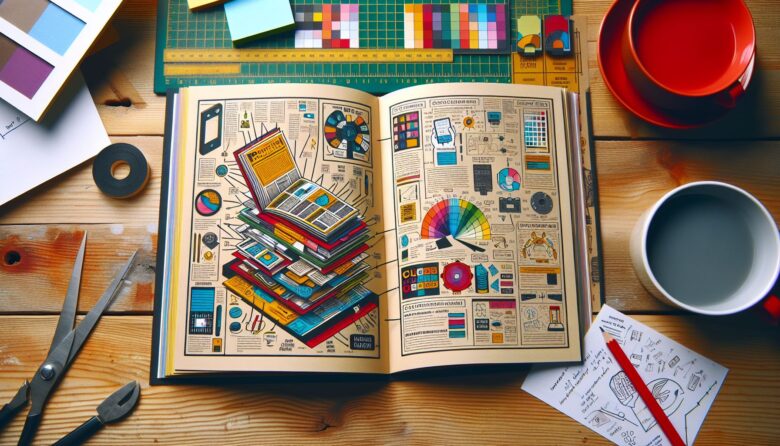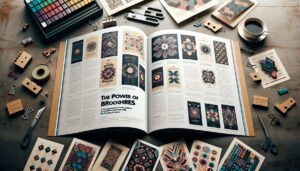Introduction
In this digital age, where online marketing has taken center stage, it’s easy to forget the importance of traditional marketing materials. However, one printing product that continues to play a vital role in advertising and communication strategies is the brochure. A well-designed and thoughtfully printed brochure can capture attention, convey information, and leave a lasting impression. In this comprehensive guide, we will delve into the world of brochure printing, exploring its significance, benefits, types, design considerations, and tips to maximize its impact.
The Power of Brochures in Visual Communication
Brochures are versatile, compact, and tangible marketing tools that allow businesses to communicate their message effectively. With their blend of captivating visuals and engaging content, brochures possess a unique power to capture the attention of potential customers and hold it for more extended periods.
Unlike digital advertisements that can be overlooked or forgotten amidst the constant scrolling, brochures provide recipients with a physical presence that demands attention. In a study conducted by Temple University, researchers found that people had a higher recall rate of information presented in hardcopy format compared to digital formats.
Moreover, brochures allow for a personal touch by giving businesses the opportunity to showcase their brand image and values through visually appealing designs and informative content. By placing a brochure directly into the hands of potential customers, businesses establish a tangible connection that fosters brand loyalty and trust.
Types of Brochures
When it comes to brochure printing, businesses have a wide array of options to choose from. Understanding the different types of brochures and their respective applications is crucial for selecting the most suitable format for your intended purpose.
Tri-fold Brochures
Tri-fold brochures, also known as letter-fold brochures, are the most popular and widely used form of brochures. As the name suggests, these brochures are folded into three equal sections, creating a compact and portable design. They often feature a front cover, back cover, and multiple panels for presenting information. Tri-fold brochures are ideal for showcasing a product catalog, presenting services, or providing an overview of a company’s capabilities.
Gatefold Brochures
Gatefold brochures feature a unique fold that involves two side panels folding inward to meet at the center, similar to opening a set of double doors. This design allows for a dramatic reveal, making it an excellent choice for highlighting a particular product or concept. The gatefold format is especially useful for creative industries like fashion, interior design, or luxury brands aiming to captivate and intrigue their target audience.
Z-fold Brochures
Z-fold brochures are named after their accordion-like fold, creating a “Z” shape. They are characterized by alternating folds that create a stacked appearance, allowing for a seamless flow of information. Z-fold brochures are particularly effective for storytelling, as the sequential arrangement allows businesses to guide readers through a narrative. This format is often chosen for travel brochures, event schedules, menus, or educational materials that require step-by-step instructions.
Bi-fold Brochures
Bi-fold brochures are simple yet impactful marketing tools that feature a single fold, dividing the brochure into two equal halves. This straightforward design provides ample space to display eye-catching visuals and concise information. Bi-fold brochures are commonly used for restaurant menus, event invitations, or promotional pamphlets.
Design Considerations for Brochures
Creating a visually appealing and impactful brochure requires careful consideration of various design elements. Here are some essential aspects to keep in mind:
1. Target Audience
Understanding your target audience is essential for designing a brochure that resonates with them. Consider their demographics, interests, and preferences when choosing color schemes, fonts, images, and language.
2. Brand Consistency
Ensure your brochure aligns with your company’s visual identity, using consistent colors, typography, and imagery. This helps reinforce brand recognition and strengthens your overall marketing message.
3. Captivating Cover
The cover is your brochure’s first impression, so make sure it grabs attention. Use compelling visuals, a catchy headline, or a unique die-cut design to entice recipients to explore further.
4. Concise Content
Brochures are not meant for excessive amounts of text. Keep your content concise, informative, and skimmable, highlighting key benefits or information to maintain readers’ interest.
5. Eye-catching Graphics
Humans are visual creatures, and incorporating high-quality images, infographics, or illustrations can enhance your brochure’s appeal and make complex information more easily digestible.
6. Call to Action
A strong call to action is a crucial element in any marketing material. Clearly communicate what action you want readers to take, whether it’s making a purchase, attending an event, or visiting your website.
Tips to Maximize the Impact of Your Brochures
Now that we understand the significance, types, and design considerations for brochures, let’s explore some tips to ensure your brochure creates a lasting impression:
-
Quality Printing: Choosing a reputable printing service that offers high-quality materials and finishes will ensure your brochures look and feel professional. Remember, the tactile experience of a well-printed brochure can enhance its effectiveness.
-
Select the Right Paper: The choice of paper can significantly impact the look and feel of your brochure. Consider factors like thickness, coating, and texture to achieve the desired effect.
-
Use Colors Strategically: Colors evoke emotions and contribute to visual hierarchy. By understanding the psychology of color, you can select hues that align with your brand identity and effectively convey your message.
-
Prioritize Readability: Ensure font sizes, styles, and spacing are suitable for easy reading. Utilize contrasting colors between text and background to enhance legibility.
-
Incorporate Interactive Elements: Make your brochures interactive by including QR codes, augmented reality features, or embossed elements. These additions can provide additional value to readers and create a memorable experience.
-
Leverage Personalization: Tailor your brochures to specific customer segments or personalize them with variable data printing. This approach fosters a sense of connection and increases engagement.
Conclusion
In a world saturated with digital advertising, the power of brochures in visual communication cannot be overlooked. As a tangible and versatile marketing tool, brochures have the potential to captivate, inform, and leave a lasting impression on potential customers. By understanding the different types of brochures, considering design elements, and implementing effective tips, businesses can unlock the full potential of this printing product. So, let brochures become an integral part of your marketing strategy and watch as your brand speaks volumes through eye-catching designs and compelling content.



